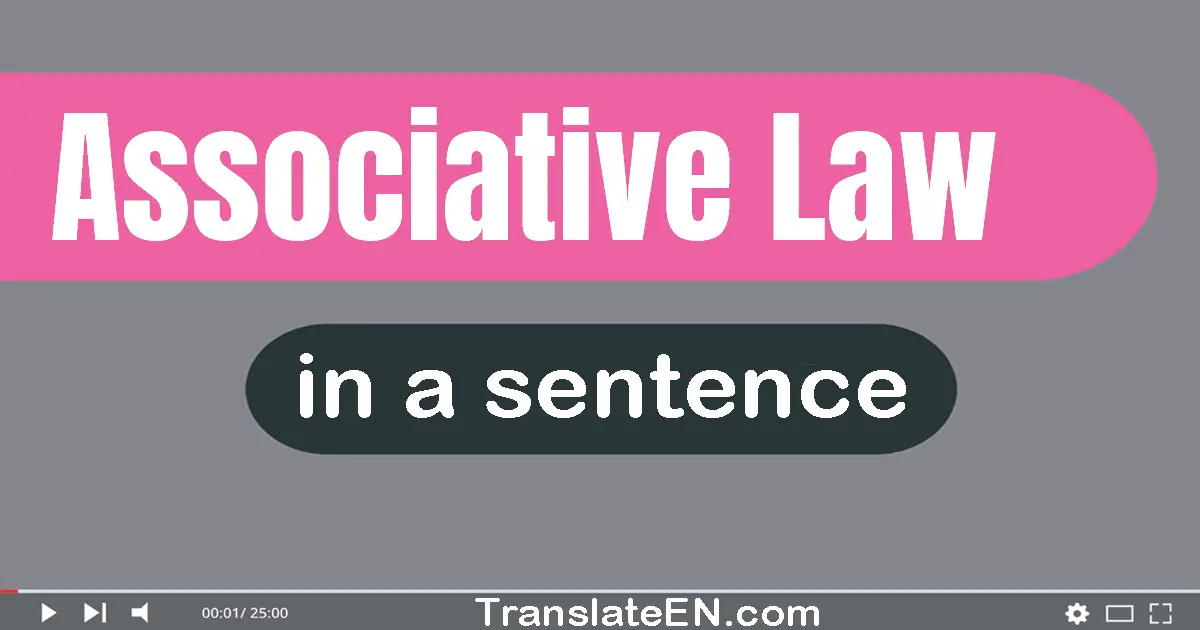Associative Law in a sentence

(1) An abelian semigroup satisfies the associative law.
(2) The associative law is a key principle in abstract algebra.
(3) The associative law is also known as the grouping property.
(4) The associative law is a fundamental concept in mathematics.
(5) Nonassociative functions do not satisfy the associative law.
(6) The associative law is often used in algebraic manipulations.
(7) The associative law is a cornerstone of mathematical reasoning.
(8) The associative law is a property that is often used in proofs.
(9) The associative law is a property that is explored in set theory.
(10) The associative law is one of the three basic laws of arithmetic.
Associative Law sentence
(11) The associative law is a property of certain mathematical structures.
(12) The associative law is used in algebra to simplify complex expressions.
(13) The associative law is a useful tool for simplifying complex expressions.
(14) The associative law is a key concept in computer science and programming.
(15) The associative law is a concept that is taught in elementary mathematics.
(16) The associative law is a property that is proven through logical arguments.
(17) The associative law is a property of sets and functions as well as numbers.
(18) The associative law is a concept that is foundational to algebraic thinking.
(19) The associative law is a principle that is applied in optimization problems.
(20) The associative law is a concept that is studied in abstract algebra courses.
Associative Law make sentence
(21) The associative law applies to addition, multiplication, and other operations.
(22) The associative law is a concept that is applied in real-world problem-solving.
(23) The associative law is a concept that is explored in advanced mathematics courses.
(24) The associative law is a property that holds true for many mathematical operations.
(25) The associative law is a principle that is used in various branches of mathematics.
(26) The associative law is a principle that is used in computer science and programming.
(27) The associative law is a principle that is used in probability theory and statistics.
(28) The associative law is a powerful tool for solving problems in many different fields.
(29) The associative law is a property that is inherent to certain mathematical structures.
(30) The associative law is a property that is used in cryptography and encryption algorithms.
Sentence of associative law
(31) The associative law is a property that is demonstrated through examples and counterexamples.
(32) The associative law is a property that is often taken for granted in mathematical reasoning.
(33) The associative law is a property that is generalized to different operations and structures.
(34) The associative law allows us to rearrange terms in an equation without changing the solution.
(35) The associative law allows us to rearrange the order of operations without changing the outcome.
(36) The associative law is a concept that is extended to matrices and other mathematical structures.
(37) The associative law states that the grouping of numbers in an operation does not affect the result.
(38) The associative law is a concept that is fundamental to the understanding of mathematical operations.
Associative Law meaning
The associative law is a fundamental concept in mathematics that is used to simplify complex equations and expressions. It states that the way in which numbers or variables are grouped together in an equation does not affect the final result. In other words, if you have a set of numbers or variables that are being added or multiplied together, you can change the order in which they are grouped without changing the final answer. For example, consider the equation (2 +
3. +
4. According to the associative law, we can group the first two numbers together and then add the third number, or we can group the second two numbers together and then add the first number. Either way, we will get the same answer: 9. The associative law is particularly useful when dealing with large or complex equations, as it allows us to break them down into smaller, more manageable parts. By rearranging the order in which the numbers or variables are grouped, we can simplify the equation and make it easier to solve. To use the associative law in a sentence, you might say something like: "The associative law allows us to rearrange the terms in this equation without changing the final result." Or, "By applying the associative law, we can simplify this expression and make it easier to solve." When using the term "associative law" in a sentence, it is important to provide context and explain what it means. This will help your audience understand the concept and how it applies to the problem at hand. In addition to its use in mathematics, the associative law can also be applied in other areas, such as computer science and linguistics. In computer science, for example, the associative law is used to optimize the performance of algorithms by rearranging the order in which operations are performed. In linguistics, the associative law is used to analyze the way in which words and phrases are grouped together in sentences.
Overall, the associative law is a powerful tool that can be used to simplify complex equations and expressions. By understanding how it works and how to apply it, you can become a more effective problem solver and communicator in a variety of fields.
The word usage examples above have been gathered from various sources to reflect current and historical usage of the word Associative Law. They do not represent the opinions of TranslateEN.com.
